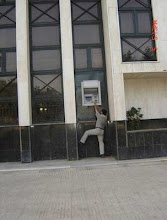The following study was done after the Savings and Loan Crisis of the 1980's.
Congressional Research Service, 1987
In the nineteenth and early twentieth centuries, bankers and brokers were sometimes indistinguishable. Then, in the Great Depression after 1929, Congress examined the mixing of the "commercial" and "investment" banking industries that occurred in the 1920s. Hearings revealed conflicts of interest and fraud in some banking institutions' securities activities. A formidable barrier to the mixing of these activities was then set up by the Glass-Steagall Act. It consists of four sections of the Banking Act of 1933. Its language makes it a felony for anyone -- banker, broker, dealer in securities, or savings institution -- to engage in the deposit-taking and securities businesses at the same time. For Federal Reserve member banks, it included reinforcing language designed to separate the two activities directly and through corporate affiliation or interlocking directorates.
In 1999, contrary to the current Clinton mudslinging of right-wing political blogs, Senator Phil Gramm (R,TX) introduced legislation to repeal Glass-Steagall. Now, I know I am ruffling some right-wing feathers out there, but don't fret. This legislative corruption was supported by Democrats, Independents, and Republicans in a firestorm of deregulation which, to this day, still rages.
LosAngeles.InjuryBoard.com
In 1999, former Senator Phil Gramm (who is, incidentally, Senator John McCain's economic adviser and cochairs his presidential campaign) set out to completely gut the Glass-Steagall Act, and did so successfully, replacing most of its components with the new Gramm-Leach-Bliley Act: allowing commercial banks, investment banks, and insurers to merge (which would have violated antitrust laws under Glass-Steagall).
So, regulations that kept the markets safe for 60 years were stripped.
In 2000, shortly after George W. Bush was elected president, Congress and President Clinton were trying to pass a $384 billion omnibus spending bill, and while the debates swirled around the passage of this bill, Senator Phil Gramm clandestinely slipped a 262-page amendment into the omnibus appropriations bill titled: Commodity Futures Modernization Act. It is likely that few senators read this bill, if any. The essence of the act was the deregulation of derivatives trading (financial instruments whose value changes in response to the changes in underlying variables; the main use of derivatives is to reduce risk for one party). The legislation contained a provision -- lobbied for by Enron, a major campaign contributor to Gramm -- that exempted energy trading from regulatory oversight. Basically, it gave way to the Enron debacle and ushered in the new era of unregulated securities.
Mr. Gramm isn't done.
http://www.commondreams.org/view/2008/09/24-1
The legislation's "Legal Certainty for Bank Products Act of 2000," Title IV of the law - a law that Gramm snuck in without hearings hours before the Christmas recess - provided Wall Street with an unbridled license to steal. It made certain that financiers could legally get away with a whole new array of financial rip-off schemes.
One of those provisions, summarized by the heading of Title III, ensured the "Legal Certainty for Swap Agreements," which successfully divorced the granters of subprime mortgage loans from any obligation to ever collect on them. That provision of Gramm's law is at the very heart of the problem. But the law went even further, prohibiting regulation of any of the new financial instruments permitted after the financial industry mergers: "No provision of the Commodity Exchange Act shall apply to, and the Commodity Futures Trading Commission shall not exercise regulatory authority with respect to, an identified banking product which had not been commonly offered, entered into, or provided in the United States by any bank on or before December 5, 2000. ..."
LosAngeles.InjuryBoard.com
In 2003, Gramm left the Senate to join UBS, which had acquired investment house PaineWebber due to his deregulation bill. At UBS, Gramm lobbied Congress, the Fed and the Treasury Department. During Gramm's tenor at UBS and as a lobbyist, Congress passed the Responsible Lending Act, billed as an anti-predatory-lending measure, but was called the "Loan Shark Protection Act" by consumer advocates, as it was designed to preempt stronger state laws against anti-predatory lending.
And, of course, The Bankruptcy Abuse Prevention and Consumer Protection Act of 2005 pulls the rest of the rug from under the American people.
The Uptick Rule
The Uptick Rule was instated in 1938 by SEC to block the downward spiral of short selling when a stock or financial instrument was taking a nose dive.
Investopedia: Uptick Rule
A former rule established by the SEC that requires that every short sale transaction be entered at a price that is higher than the price of the previous trade. This rule was introduced in the Securities Exchange Act of 1934 as Rule 10a-1 and was implemented in 1938. The uptick rule prevents short sellers from adding to the downward momentum when the price of an asset is already experiencing sharp declines.
Since 1938, short selling on the down-tic was outlawed until July 2007 when the SEC struck down the measure. The "UpTick Rule" kept the stock market from collapsing by a rush to hedge on the fall of stocks.
TraderMike.net
The SEC has voted to remove the “short sale tick test”, Rule 17 CFR 240.10a-1 for all equity securities. Effective Friday, July 6, traders will be able to short all securities on an up, down, or zero tick.
The Commission first imposed restrictions on the execution prices of short sales almost seventy years ago, when we adopted the "tick test" of Rule 10a-1 in 1938. The tick test permits short sales only at a price above the last sale price, or alternatively, at the last sale price -- if that is higher than the previous price.
Globalization will be the topic of discussion in my next Part II of this series.
***





No comments:
Post a Comment